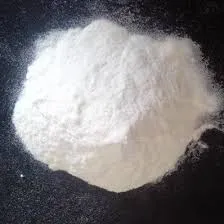
നവം . 29, 2024 12:16 Back to list
HPMC Applications in Gypsum Plaster for Enhanced Performance and Durability
The Role of HPMC in Gypsum Plaster Enhancing Performance and Workability
Hydroxypropyl Methylcellulose (HPMC) is a versatile cellulose ether that has gained significant popularity in the construction industry, particularly in applications involving gypsum plaster. Its unique properties make it an essential additive for improving the performance and workability of gypsum-based materials. This article delves into the role of HPMC in gypsum plaster, exploring its benefits, applications, and impact on the overall quality of construction projects.
What is HPMC?
HPMC is a non-ionic, water-soluble polymer derived from cellulose. It is synthesized through a series of chemical reactions that modify cellulose by adding hydroxypropyl and methyl groups. The resulting product exhibits excellent water retention, thickening, and binding properties, making it ideal for various construction materials. In the context of gypsum plaster, HPMC serves as a crucial additive that enhances the plasters' performance characteristics.
Enhancing Workability
One of the primary benefits of incorporating HPMC in gypsum plaster is the improvement in workability. Gypsum plaster is known for its rapid setting time, which can pose challenges for applicators. The addition of HPMC significantly extends the open time of the plaster, allowing for better manipulation and application. This extended workability enables plasterers to achieve a smooth finish and work on larger areas without the pressure of quick setting. As a result, HPMC helps reduce the likelihood of application errors, ensuring a more consistent and professional end result.
Water Retention
Another critical advantage of HPMC in gypsum plaster is its superior water retention capability. Gypsum plaster can become too dry if moisture is lost too quickly, leading to cracking and compromising the integrity of the finishing layer. HPMC creates a gel-like structure that traps water within the plaster mixture, ensuring that it remains workable longer. This improved water retention not only facilitates better bonding with substrates but also enhances the overall durability of the plaster once set. The end product is a strong, resilient surface ideal for various finishing applications.
hpmc for gypsum plaster

Improved Adhesion and Flexibility
The incorporation of HPMC into gypsum plaster also contributes to improved adhesion and flexibility. HPMC molecules can bond effectively with gypsum crystals, creating a more cohesive and durable material. This enhancement is particularly beneficial when applying plaster over different substrates, such as concrete, brick, or wood, where adhesion can be a concern. Moreover, the flexible nature of HPMC helps the plaster absorb and accommodate minor structural movements, reducing the risk of cracking and ensuring longevity.
Enhancing Surface Finish
The surface finish of gypsum plaster is crucial for aesthetic and functional purposes. The inclusion of HPMC leads to a smoother, more uniform surface finish, essential for the application of paints and other finishes. The improved rheological properties of the plaster mean that it can be spread more easily and evenly, minimizing the occurrence of defects such as bumps and uneven areas. This clean and polished surface not only enhances the visual appeal but also improves the overall performance of subsequent layers.
Environmental Benefits
In addition to performance enhancements, HPMC offers environmental advantages. It is derived from renewable resources, and its use in gypsum plaster can contribute to the sustainability of construction practices. HPMC can also reduce the amount of water required for mixing plaster, promoting more sustainable water usage in building projects. By minimizing waste and improving the overall efficiency of plaster applications, HPMC supports the ongoing shift towards greener construction materials.
Conclusion
In conclusion, Hydroxypropyl Methylcellulose (HPMC) plays a vital role in enhancing the performance of gypsum plaster. Its benefits in terms of workability, water retention, adhesion, flexibility, and surface finish make it an indispensable additive in plaster formulations. As the construction industry continues to evolve, the integration of innovative materials like HPMC will remain crucial in providing high-quality, durable, and sustainable finishing solutions. With its ability to improve the overall quality of gypsum plaster, HPMC is set to be a key player in future construction practices.
-
The Widespread Application of Redispersible Powder in Construction and Building Materials
NewsMay.16,2025
-
The Widespread Application of Hpmc in the Detergent Industry
NewsMay.16,2025
-
The Main Applications of Hydroxyethyl Cellulose in Paints and Coatings
NewsMay.16,2025
-
Mortar Bonding Agent: the Key to Enhancing the Adhesion Between New and Old Mortar Layers and Between Mortar and Different Substrates
NewsMay.16,2025
-
HPMC: Application as a thickener and excipient
NewsMay.16,2025
-
Hec Cellulose Cellulose: Multi functional dispersants and high-efficiency thickeners
NewsMay.16,2025







